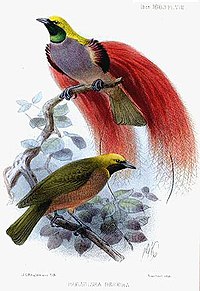
Photo from wikipedia
Anthropogenic increases in nutrient availability offer opportunities to study evolutionary shifts in sexual selection dynamics in real time. A rapid increase in nutrient availability may reduce the utility of condition-dependent… Click to show full abstract
Anthropogenic increases in nutrient availability offer opportunities to study evolutionary shifts in sexual selection dynamics in real time. A rapid increase in nutrient availability may reduce the utility of condition-dependent ornaments as signals of quality and lessen any nutritional benefits to females from re-mating. We explored these ideas using cabbage white butterflies, focusing on nitrogen as a nutrient, as it is important to this species in not only in ornamentation, but also as a key macronutrient transferred in spermatophores. We compared a nonagricultural population to an agricultural population, which has seen an increase in nitrogen availability over the last 40 years due in part to fertilizer application. When reared in a common garden, both male and female butterflies from the agricultural population allocate significantly more to nitrogen-rich wing pigments used in mate choice. However, this increase in allocation is not correlated with an increase in the ability to assimilate nitrogen from their diet. Spermatophore counts from wild females show that females in the agricultural population rarely mate more than once, while those in the nonagricultural population are much more likely to be polyandrous. Similarly, the structure in the female reproductive tract that processes spermatophores has evolved lower tooth density in the agricultural population, consistent with the idea that these females benefit less from high throughput of spermatophores. These results suggest that anthropogenic increases in nutrient availability have resulted in a decline in the nutritional benefits of remating in females along with evolutionary increases in ornamentation in both males and females.
Journal Title: Behavioral Ecology
Year Published: 2019
Link to full text (if available)
Share on Social Media: Sign Up to like & get
recommendations!